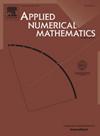General enrichments of stable GFEM for interface problems: Theory and extreme learning machine construction
IF 2.4
2区 数学
Q1 MATHEMATICS, APPLIED
引用次数: 0
Abstract
Generalized finite element methods (GFEMs), when applied to interface problems (IPs), need to be enriched with special functions to enhance approximation accuracy. These functions include distance functions, one-side distance functions, level set functions, and exponential forms of level set function. For the IP with geometrically complex interface curves, computation of the distance function or level set function could be challenging, and algorithms of computational geometry are usually involved. Moreover, theoretical analysis on optimal convergence of the GFEM enriched by these functions has not been fully investigated. In this study we propose a general enrichment scheme, based on which all the aforementioned enrichments can be viewed as special examples. We prove that a stable GFEM (SGFEM) with such a new enrichment scheme reaches the optimal convergence rate. Most importantly, the new scheme provides an instruction to construct machine learning (ML) based enrichments, which advances the ability of GFEM to handle geometrically complex interfaces. Two ML methods, deep neural network (DNN) and extreme learning machine (ELM), are studied. Among them, the ELM is highly suggested because it exhibits high accuracy for the interface curve with complex geometries. The learning dimension for the ML is one dimension less than that of the domain so that the proposed ML algorithm can be implemented efficiently. The numerical experiments demonstrate that the SGFEM with the ELM enrichment achieves the optimal convergence rates for the IP, as predicted theoretically.
用于界面问题的稳定 GFEM 的一般增量:理论与极端学习机构建
广义有限元方法(GFEM)在应用于界面问题(IP)时,需要使用特殊函数来提高近似精度。这些函数包括距离函数、单边距离函数、水平集函数和水平集函数的指数形式。对于具有复杂几何界面曲线的 IP,距离函数或水平集函数的计算可能具有挑战性,通常涉及计算几何的算法。此外,关于用这些函数富集的 GFEM 最佳收敛性的理论分析尚未得到充分研究。在本研究中,我们提出了一种通用的富集方案,在此基础上,所有上述富集方案都可视为特例。我们证明,采用这种新的富集方案的稳定 GFEM(SGFEM)能达到最佳收敛率。最重要的是,新方案为构建基于机器学习(ML)的富集提供了指导,从而提高了 GFEM 处理几何复杂界面的能力。研究了两种 ML 方法,即深度神经网络(DNN)和极限学习机(ELM)。其中,ELM 被强烈推荐,因为它对复杂几何形状的界面曲线表现出很高的精度。极限学习机的学习维度比域的维度小一维,因此可以高效地实现所提出的极限学习机算法。数值实验证明,正如理论预测的那样,富含 ELM 的 SGFEM 可实现 IP 的最佳收敛率。
本文章由计算机程序翻译,如有差异,请以英文原文为准。
求助全文
约1分钟内获得全文
求助全文
来源期刊

Applied Numerical Mathematics
数学-应用数学
CiteScore
5.60
自引率
7.10%
发文量
225
审稿时长
7.2 months
期刊介绍:
The purpose of the journal is to provide a forum for the publication of high quality research and tutorial papers in computational mathematics. In addition to the traditional issues and problems in numerical analysis, the journal also publishes papers describing relevant applications in such fields as physics, fluid dynamics, engineering and other branches of applied science with a computational mathematics component. The journal strives to be flexible in the type of papers it publishes and their format. Equally desirable are:
(i) Full papers, which should be complete and relatively self-contained original contributions with an introduction that can be understood by the broad computational mathematics community. Both rigorous and heuristic styles are acceptable. Of particular interest are papers about new areas of research, in which other than strictly mathematical arguments may be important in establishing a basis for further developments.
(ii) Tutorial review papers, covering some of the important issues in Numerical Mathematics, Scientific Computing and their Applications. The journal will occasionally publish contributions which are larger than the usual format for regular papers.
(iii) Short notes, which present specific new results and techniques in a brief communication.
 求助内容:
求助内容: 应助结果提醒方式:
应助结果提醒方式:


